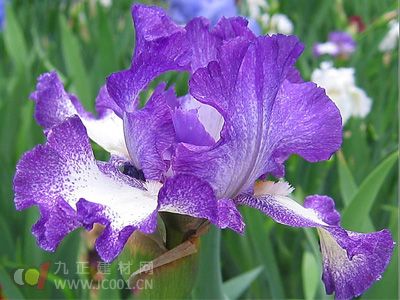Persian Iris Cultivation Techniques:
1. Planting Location
Persian iris can be grown in a variety of environments, including glass or plastic greenhouses, as well as open fields. When planting outdoors, temporary coverings or mobile greenhouses are effective options, especially during spring and autumn.
Choosing the right location is essential for successful growth. Key factors to consider include the appropriate growing stage, ideal climate conditions, and the type of greenhouse available.

For example, if temperatures drop below 5°C during the growing phase, it's best to plant in a greenhouse. This helps prevent frost damage, which can halt plant development. In other seasons, when temperatures stay under 25°C, greenhouse planting is also suitable. If outdoor temperatures remain above 5°C and soil temperatures do not exceed 20°C, planting directly in the field is possible. Greenhouses offer better control over temperature and humidity through ventilation and shading, improving overall crop quality. In temperate regions, flowers grown in summer tend to be of higher quality than those in poorly ventilated greenhouses.
2. Soil Conditions
For cut flower production, Persian iris can thrive in any well-drained soil that retains moisture without becoming compacted. A good soil structure is crucial for healthy root development during the growing season.
In heavy clay soils, it's recommended to mix in materials like peat, vermiculite, or coarse sand up to a depth of about 25 cm to improve drainage and aeration. After planting, mulching with rice husks, straw, pine needles, or black peat can help prevent soil compaction and reduce evaporation. Additional methods such as drip irrigation can also help maintain soil moisture.
3. Drainage System
A reliable drainage system is essential to remove excess water quickly and prevent waterlogging. This also allows for washing the greenhouse soil with water, which helps reduce salt buildup from insufficient watering during certain growth stages.
4. Salt Sensitivity
Persian iris is highly sensitive to salt. Excessive salt in the soil can slow root growth and even cause root damage, leading to poor water uptake and dehydrated flowers. To reduce salt levels, the soil should be thoroughly leached before planting—using approximately 200–400 mm of water per square meter.
Soils used for crops like chrysanthemums, roses, or tomatoes often have high salt content due to frequent fertilization. Similarly, late-harvest crops like cypress may increase salinity. Therefore, avoid using large amounts of synthetic fertilizers before or after planting. Conduct a soil test at least six weeks prior to planting to determine salt levels.
The following salt levels must not exceed the recommended limits: Total salinity (conductivity) 1.0–1.5 millimoles at 25°C, chloride salts 1.5–2.0 milliequivalents, potassium salts 0.8–1.5 milliequivalents, nitrogen salts 1.0–2.0 milliequivalents, magnesium salts 2.0 milliequivalents, and phosphorus salts no more than 5.0 mg per liter.
The electrical conductivity of irrigation water must not exceed 0.5 millisiemens/cm. Chloride levels in greenhouses should not go above 50 mg/l, and in open fields, they should not exceed 450 mg/l. If irrigation water doesn’t meet these standards, planting is not advisable. However, if salt levels are too high, keep the soil as moist as possible to prevent further salt accumulation.
5. Fertilization
It’s generally not recommended to apply base fertilizer before planting, as it can increase salt concentration and delay root growth. A soil test should be conducted before planting to ensure proper nutrient levels. Testing should be done after soil treatment and leaching so that future fertilization can address specific deficiencies. Persian iris is sensitive to fluorine, so fluorine-containing fertilizers, such as phosphate-based ones, should be avoided. Instead, use bisphosphonate fertilizers.
6. Weed Control
The growth cycle of Persian iris is relatively short—only 8–12 weeks. During this time, if the soil has been steamed, flooded, or tilled beforehand, weed control may not be necessary. After planting, herbicides are commonly used, but care must be taken to avoid damaging the plants.
If weeds appear after planting, herbicides can only be applied once the bulbs are deep enough in the soil. New shoots will be safe from herbicide effects if they are at least 2 cm below the surface. Before planting, weeds in greenhouses or open fields can be controlled by applying a suitable herbicide. If common herbicides don’t work on certain weeds, use a compound herbicide instead. Apply it when the sky is dark and follow with sufficient water. Rinse the plants the next morning. Remember to limit herbicide use to no more than two times per plot annually, and avoid using them on herbicide-sensitive varieties.
Surface Centrifugal Pump,Surface Centrifugal Pumps,Homemade Centrifugal Pump,Self-Priming Surface Centrifugal Pump
Zhengzhou Shenlong Pump Industry CO.,Ltd , https://www.waterpump-manufacturer.com